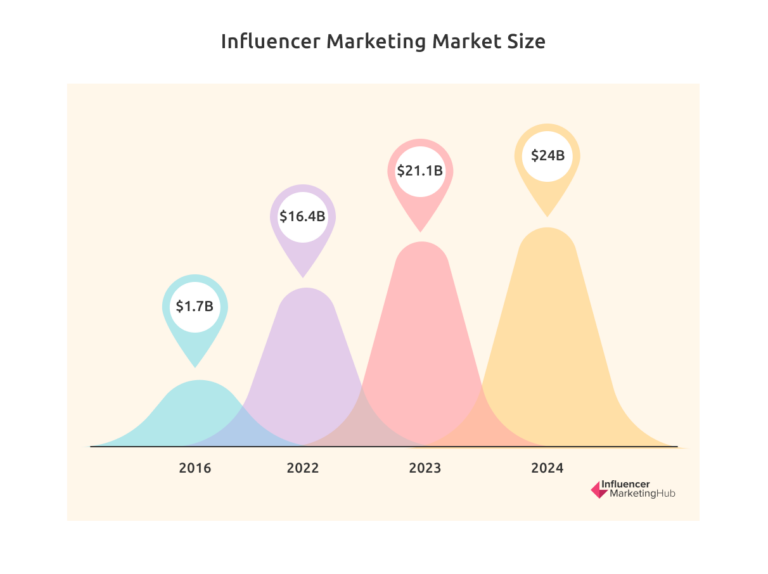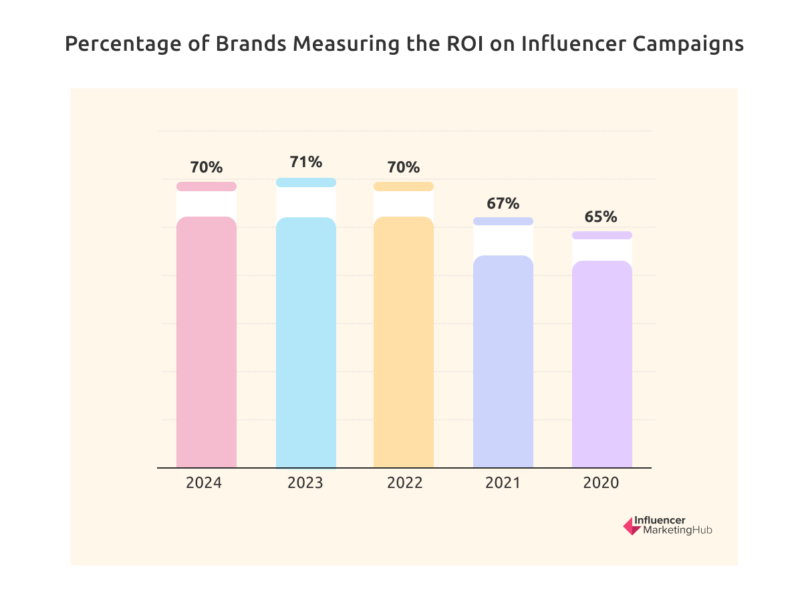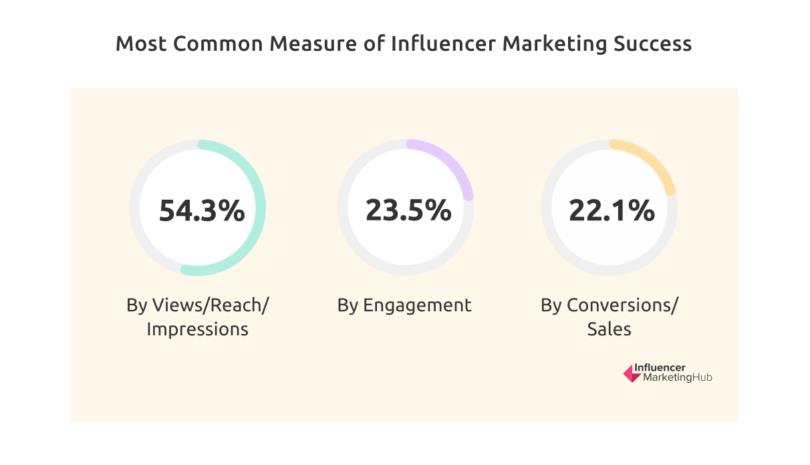
In 2024 the influencer marketing industry is projected to reach $24 billion, according to a new report from Influencer Marketing Hub, powered by social media platforms like Instagram and TikTok and the increasing adoption of AI.
The report surveyed more than 3,000 marketing agencies, brands and industry professionals, and outlines the significant trends, challenges and strategies shaping the future of influencer marketing.
“The ability to adapt to emerging trends and leverage cutting-edge technologies will define the success of influencer marketing strategies in 2024,” the report advises. It also provides key statistics, industry insights and best practices for marketers and brands alike.

Companies typically earn $5.20 for each dollar invested, Influencer Marketing Hub reported in January, and for the highest-performing of businesses (roughly 13%), the return balloons up to $20 or more for every dollar expended. But how are brands achieving such substantial ROI in this crowded digital landscape? According to the “Influencer Marketing Benchmark Report 2024,” the answer lies in strategic, authentic influencer marketing.
READ MORE: What is Influencer Marketing? – The Ultimate Guide for 2024 (Influencer Marketing Hub)
NAB Amplify breaks down the highlights of this substantial report in a two-part look at the data. Here in Part 1 we examine the key drivers fueling the remarkable growth of the burgeoning industry, including how brands are measuring ROI and the dominance of platforms like Instagram and TikTok, which are transforming the digital marketing landscape.
Stay tuned for Part 2, which explores the use of artificial intelligence in influencer marketing, and highlights the critical role of micro-influencers, whose highly engaged communities offer substantial returns on investment for brands.
Cash for Clout
A look at the numbers shows that budgets for influencer marketing are mostly holding steady as companies navigate the challenges of a post-pandemic economy. Marketers remain highly optimistic about the value of influencer marketing overall. Nearly 85% agree that it is an effective way to reach consumers and increase sales, up from 83% in 2023 but still lower than the 90% reached in 2022.
More importantly, most agree that influencer marketing attracts high-quality customers, with 83.8% believing that the quality of customers from influencer marketing campaigns is better than other marketing types.

Almost one-quarter (24.2%) of respondents are “dedicated fans” of influencer marketing, intending to spend more than 40% of their marketing budget on influencer campaigns. Comparable with 2023’s 23%, this is a massive increase over just 5% of respondents in 2022, 11% in 2021 and 9% in 2020.
The report found that 85.8% of respondents intend to dedicate budget to influencer marketing in 2024, and 59.4% plan to increase their investment. Moreover, 26% intend to spend upwards of 40% of their marketing budget on influencer marketing. This is a modest increase from last year’s 82% and considerably up from the 37% who claimed they would dedicate a budget in Influencer Marketing Hub’s first survey in 2017.

The average annual spend on influencer marketing per brand is estimated at $100,000, says the report. Although most brands spend less than $50,000 on influencer marketing, nearly 15% spend more than $500,000. Almost half (47.4%) of the brands surveyed said they spend less than $10,000 annually on influencer marketing (higher than last year’s 43% ). Nearly 21% (20.9%) spent between $10,000 and $50,000 (down from last year’s 22%). A further 8.9% spent $50,000 to $100,000 (noticeably lower than 2023’s 14%), 8.3% $100,000 to $500,000 (down from 10%), with a sizable 14.5% spending more than $500,000 (up from last year’s 11% and nearly four times more than in 2022).
On a side note, nearly two-thirds of survey respondents (65.8%) maintain a standalone budget specifically for content marketing. This figure inches upwards each year, rising from 63% in last year’s survey, 61% in 2022, 59% in 2021, and 55% in 2020.
Measuring ROI
Measuring ROI and campaign results is crucial to running a successful influencer marketing program, but only 13.6% of those surveyed reported that it was a top concern. That’s down from 14.9% in 2023, and nearly 30% (28.1%) in 2022.
That said, 70% of marketers do measure ROI.
The survey found that nearly 80% of respondents stated that they track sales from their influencer campaigns. “Therefore, it should be no surprise that a similar number (70%) also measure the ROI from their influencer campaigns. This is slightly down on 2023’s 71%, but better (or equal) to 2022’s 70%, 2021’s 67%, and 2020’s 65% results.”
The report adds: “It is somewhat surprising that 30% of firms don’t measure their ROI. You would think that every firm would want to know how effective their marketing spending is. At least there is a gradual improvement in this metric, and hopefully, this trend will continue, if not accelerate.”

The most common measure of influencer marketing success is views/reach/impressions. “This result shows a marked change from previous years,” the report notes, “yet it seems inconsistent with increases in firms tracking sales and paying influencers based on the sales they generate.”
Leading up to 2019, influencer marketing measurement’s focus was relatively evenly balanced between differing campaign goals, but conversion/sales was the least-supported reason. However, in 2020 things changed, with conversions/sales taking the lead, which continued in 2021 and 2022. In 2023, however, things changed, with nearly half of respondents stating that they measure the success of an influencer marketing campaign by views/reach/impressions.
“This trend continued this year. An even higher 54.3% of our respondents stated that they measure the success of an influencer marketing campaign by views/reach/impressions, 23.5% by engagement or clicks, and just 22.1% by conversions/sales.”

Earned Media Value, or what is now being called Influencer Media Value, has become more recognized in recent years as a good measure of influencer campaigns’ ROI. Influencer Marketing Hub asked respondents whether they considered it a fair representation. This year, 80.7% favor it against 19.3% who don’t, similar to last year’s results.
“Earned Media Value provides a proxy for the returns on the posts that an influencer has historically given the firms they have worked with. It indicates what an equivalent advertising campaign would cost for the same effect. EMV calculates the worth you receive from content shared by an influencer.”
READ MORE: What exactly is an Influencer’s Media Value [Free Influencer Media Value Calculator] (Influencer Marketing Hub)
The downside is that EMV can be complicated, and it can sometimes be difficult for marketers to explain the concepts to their managers. Presumably, the survey notes, “most of the 19% against using the statistic either don’t understand it or struggle to communicate its worth to their management team.”
Loving the Algorithm
TikTok is on the rise, and continues to be the most common channel used by most brands engaging in influencer marketing, the report finds. Utilized by 69% of brands, it is by far the most popular influencer marketing channel, now well ahead of Instagram (47%), YouTube (33%) and Facebook (28%)
“It wasn’t until 2021 that TikTok made its first appearance in our charts, rising from merely being lumped in ‘Other’ in 2020 to 45% usage in 2021. It kept its popularity in 2022, increasing slightly to 46%, but dropping a position to third. In 2023, however, TikTok came into its own, taking over first place, used by 55.5% of brands tapping into it for influencer marketing campaigns.”
This year, the short-form video platform has skyrocketed, “with even grey-haired marketers understanding the importance of including TikTok in their channel mix and now 68.8% of those respondents who engage in influencer marketing include TikTok in the channels they tap into.”

This is a huge shift, given that until just last year Instagram was the network of choice for influencer marketing campaigns. In 2022 it was used by 79% of respondents for influencer marketing. It is still popular, but this year “only” 46.7% of brands go to Instagram when they decide to participate in influencer marketing, dropping it down to second place. “This is the first time we have found fewer than 50% of respondents to include Instagram in their plans,” the report states.
Surprisingly, Facebook jumped in popularity as an influencer marketing channel in 2023, with 50% of brands working with Facebook influencers, but then fell back to just 27.5% this year. “This is interesting, because we saw a resurgence in Facebook popularity in this year’s ‘Social Media Marketing Benchmark Report,’ indicating a difference in brands’ approaches to Facebook marketing when paying influencers compared to their own marketing efforts.”
READ MORE: Social Media Marketing Benchmark Report 2024 (Influencer Marketing Hub)
While Facebook doesn’t have as many high-profile influencers as its more visual counterparts, it remains relevant, the report finds, particularly with older audiences, and has a seasoned advertising marketplace.
“Many of the other social channels have seen reduced usage for influencer marketing compared to last year,” says Influencer Marketing Hub. “For example, 33.1% of the respondents tapped into YouTube for their campaigns (38.3% last year and 44% in 2022), 9.9% X/Twitter) (14.4% in 2023, 23% in 2022), 9.6% LinkedIn — presumably those involved with B2B companies (10.1% in 2023, 20% in 2022), 7.9% Twitch (6.3% in 2023, 11% in 2022), and a further 14.7% spread across the less popular or more specialist social networks (12.8% in 2023, 7% in 2022).”
Challenges in Influencer Marketing
Despite its many benefits, influencer marketing presents several challenges that marketers must navigate to ensure successful campaigns. One of the biggest ones is identifying the right influencers for a brand’s specific needs. According to the report, 45% of marketers find it challenging to identify influencers who align with their brand values and can effectively engage their target audience. This difficulty arises from the sheer volume of influencers available and the nuances involved in matching an influencer’s style and audience with a brand’s objectives.
Fraud and inauthentic engagement also pose serious concerns for brands. According to the report, 25% of brands encounter issues related to influencer fraud, such as fake followers and engagement. These fraudulent activities can undermine the effectiveness of campaigns, leading to wasted budget and reduced trust in influencer marketing as a whole. Ensuring the authenticity of an influencer’s following and engagement is crucial for brands to achieve genuine results and maintain the integrity of their marketing efforts.
Addressing these challenges requires a strategic approach. Brands must invest in tools and technologies that can help identify the most suitable influencers, track campaign performance, and detect fraudulent activities. By overcoming these hurdles, marketers can harness the full potential of influencer marketing, creating impactful and authentic connections with their audiences.
READ MORE: The State of Influencer Marketing 2024: Benchmark Report (Influencer Marketing Hub)

Why subscribe to The Angle?
Exclusive Insights: Get editorial roundups of the cutting-edge content that matters most.
Behind-the-Scenes Access: Peek behind the curtain with in-depth Q&As featuring industry experts and thought leaders.
Unparalleled Access: NAB Amplify is your digital hub for technology, trends, and insights unavailable anywhere else.
Join a community of professionals who are as passionate about the future of film, television, and digital storytelling as you are. Subscribe to The Angle today!


